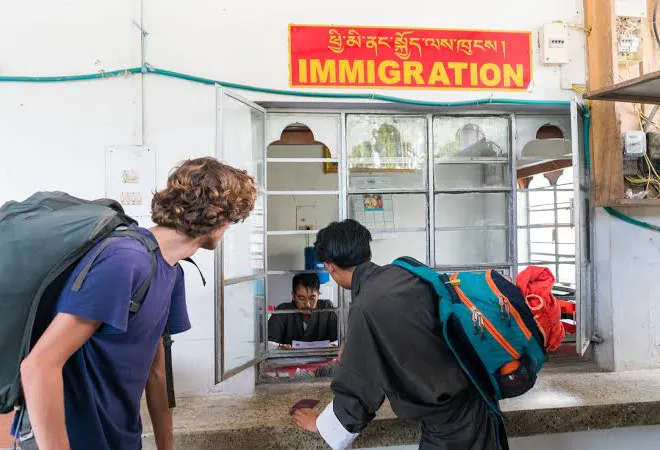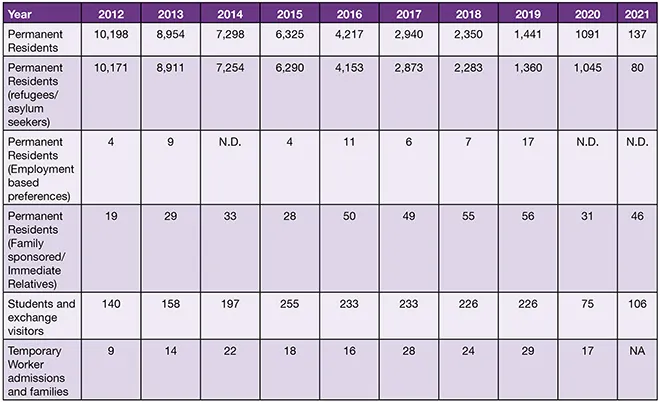
In mid-2021, the
Bhutanese Prime Minister asserted that the fertility rate in the country is decreasing, and “we do not want a Bhutan without Bhutanese and we also do not want these very few Bhutanese working elsewhere”. Of late, Bhutan is witnessing a new challenge—a massive exodus. In the last two years, more than
11,000 Bhutanese youths got their education visas from Australia alone. Several experienced and mid-level
civil servants,
teachers,
medical specialists, and
employees of private and state-owned enterprises have also left the country in search of better opportunities. For a country with a population of
less than 800,000, a shortage of manpower is being felt in
every sector. Concerns of demographic challenges, ageing population, decreasing economic
activities and productivity have been
surfacing in the parliament and media houses. A variety of push and pull factors have contributed to this challenge, and the Government of Bhutan is ushering in much-needed reforms. Yet, how these reforms will impact and shape the country’s future is yet to be seen.
Several experienced and mid-level civil servants, teachers, medical specialists, and employees of private and state-owned enterprises have also left the country in search of better opportunities.
Flying them out: In search of employment and education
Being a landlocked country with difficult topographical and climate conditions, Bhutan has long been facing the challenge of limited economic growth and unemployment. While the country’s universal education and healthcare policies have improved the quality of the population and
increased the labour force, there is a
mismatch in the job market’s demand and supply. Bhutan’s economy has largely been
dependent on labour-driven capital-intensive growth and hydroelectricity generation. This has contributed to the problem of youth unemployment and
unemployability. From
9.6 percent in 2013 to
12.3 percent in 2017 and then to
21 percent in 2021, Bhutan’s Youth unemployment has only increased with time.
As the problem exaggerated in subsequent years, Bhutan opened the international labour market for its youth. Starting in the mid-2010s, the government signed new
MOUs with other countries and began to closely
coordinate with companies that were seeking to employ Bhutanese nationals. It
provided infrastructure and training facilities to these firms and
forbade its citizens to work as domestic maids and drivers. On the other hand, to promote young unemployed Bhutanese to access the international market, it began to provide cheap
loans to travel to some of these countries. The government was also willing to ease its migration
restrictions if its youth managed to secure a permanent job.
In 2015, Bhutan signed an
MoU with Thailand, formalising that the latter will employ over 12,000 Bhutanese workers. The same year, the government sent the first batch of 100 Bhutanese workers to
Kuwait. In 2017, the government initiated new loan schemes to help youth find job
opportunities in Australia. That year, the first batch of Bhutanese was also sent to Japan for a
Learn and Earn programme.
In 2019, the government also agreed on another employment program with Japan called Technical Internship Training Programme. By the time COVID stuck, young Bhutanese were largely
working in India, United Arab Emirates (UAE), Kuwait, Qatar, Thailand, Japan, and Australia.
The government was also willing to ease its migration restrictions if its youth managed to secure a permanent job.
However, as COVID-19 and strict lockdowns triggered
economic difficulties in Bhutan, fellow Bhutanese earning well and having a better lifestyle in other countries acted as a
pull factor. Pre-existing
challenges in Bhutan such as disappointments with pay, lack of professional development, poor working conditions, lack of exposure and heavy workload, combined with systemic issues of employment and education, fears of job insecurity, relaxed work hours abroad, and reopening of international borders
triggered a mass exodus. Students, unemployed youth, and working professionals now began to leave the country in search looking for a better lifestyle and jobs.
Assessing the migration patterns:
Accounting for the people registered with various Bhutanese embassies and missions, the Ministry of Foreign Affairs and External Trade (MOFAET)
disclosed that over 32,258 Bhutanese are living in 113 countries. However, with limited data collection and recording, the true nature of the challenge remains unknown. On par with MOFAET’s disclosure, Table 1 indicates the top destinations of Bhutanese citizens. A closer assessment of this estimate with data from other countries indicates that migration from Bhutan is primarily driven by employment opportunities, and is followed by educational opportunities.
Table 1. Top destinations for Bhutanese Citizens
 Source: The Bhutanese
Source: The Bhutanese
Push factors in Bhutan, combined with better standards of life, economic opportunities, relaxed work hours, and education opportunities in Australia has attracted several Bhutanese in recent years. In 2021, the Australian census indicated that over
12,000 Bhutanese stayed in Australia. The migration trend has largely
increased in recent years—coinciding with Bhutan’s attempt to open to the international labour market. Between
2001-2010 over 1,579 Bhutanese arrived in Australia. This increased to 3,290 between
2011-2015, and then to 6,993 between
2016-2021. Over
67 percent of these migrants do not attend any educational institutions—indicating that employment remains a priority. In terms of education, Australia has gradually replaced India as a favourite destination for the Bhutanese. Between 2002-2020 Australia hosted over
5,803 Bhutanese students. In 2021, the number of Bhutanese students studying in Australia increased to
2,659 and had further rocketed to
4,151 by 2022.
Students, unemployed youth, and working professionals now began to leave the country in search looking for a better lifestyle and jobs.
Economic opportunities, negligible visa restrictions, regular training programmes, education opportunities, and Buddhist
tourism and
education have bolstered people-to-people relations between India and Bhutan for generations. Until the recent statistics from MOFAET, India was the
top destination for Bhutanese citizens. The percentage of Bhutanese students and the average number of Bhutanese students studying in India has been on a decline in the previous years (refer to Table 2). Bhutanese students are likely to find alternative destinations for their education, such as Australia. Despite the lack of data on
Bhutanese citizens working in India, it can be presumed that employment remains the prime cause of migration. For instance,
in 2017 India hosted over 6580 Bhutanese citizens out of which only 2,284 were students (refer to Table 2)—indicating that a majority of them were employed, or looking for job opportunities.
Hospitality,
call centres, beauty parlours, salons, and other related industries remain some key employers of Bhutanese citizens.
Table 2. Bhutanese students in India
 Source: All India Survey on Higher Education (2012-2021)
Source: All India Survey on Higher Education (2012-2021)
Employment, better salaries, and standard of living have motivated Bhutanese to migrate to Gulf countries such as Kuwait, UAE, and Qatar. While migration channels to Kuwait existed since 2014, other Gulf countries have become attractive
in recent years with higher visa rejections for diploma courses in Australia and the freezing of education loans in Bhutan. The labour force in these countries is both school and college graduates. In Qatar, however, over 70 percent of the Bhutanese workforce consists of
graduates.
International universities, cultural affinity, and job opportunities have attracted several Bhutanese to
Thailand. In 2020, Thailand was the
third most preferred destination for Bhutanese students, after Australia and India. Bhutan has also pushed its citizens to seek permanent jobs and volunteering opportunities in Thailand. Starting in 2012, Bhutanese citizens were permitted to teach English in
Thailand.
Recruitment agencies have also been attempting to employ Bhutanese citizens in other industries – such as ship industries and hospitality.
With education and employment being the pull factor, Bhutanese migration to the US is much more complicated. In the
year 2000, the United States (US) was hosting over 200 Bhutanese citizens. Today, most Bhutanese staying in the USA have sought their permanent residency permits as refugees/ asylum seekers (refer to Table 3) and are less of a concern for Bhutan’s current migration challenge. The primary migration challenge in the US emanates from Bhutanese students in the US. Following this, Bhutanese families and immediate relatives have played an important role in facilitating migration to the US. Only a handful of Bhutanese has been staying in the US on temporary work visas. Even lesser Bhutanese have managed to use their employment experience to be permanent residents in the US.
Table 3. Bhutanese citizens in the USA
 Note: NA – Not Available; N.D. – Not Disclosed
Note: NA – Not Available; N.D. – Not Disclosed
Source: Yearbook of Immigration Statistics, Department of Homeland Security (2012-2021)
Charting its way ahead:
With this prevalent challenge, the Government of Bhutan has implemented some much-needed large-scale reforms. In late 2022 alone, the government introduced
46 reform acts in the parliament. These reforms intend to introduce
lateral entries in the civil services,
restructure ministries and organisations, and also
increase the services’ accountability, pay scales and retirement age.
Measures are also being taken to limit the red tape bureaucracy and promote the private sector, investments, businesses, and economic activities in the country. Reforms have also swept through the education sector to generate more skills and employability. Academic programmes which exaggerated the country’s job market mismatch have been
removed or redesigned.
With education and employment being the pull factor, Bhutanese migration to the US is much more complicated.
The government has also mandated the Gyalsung project. Under this programme, Bhutanese citizens attaining the age of 18 will undergo a one-year training programme that
includes three months of basic military training, followed by nine months of specialised training in fields such as construction technologies, computing, entrepreneurship, agriculture, etc. The project will
commence in 2024 and involve over
13,000 Bhutanese youth. It is expected that this program will instil
patriotism and upskill the youth, and will bridge the demand-supply mismatch in the job market and prevent further brain drain in the country.
The timely implementation of these reforms has certainly invoked some optimism within Bhutan. However, their impact and efficiency to improve the country’s economic situation and mitigate further migration will be detrimental to the country’s future.
The author would like to thank ORF intern Harris Amjad for his assistance with the preliminary data collection
The views expressed above belong to the author(s). ORF research and analyses now available on Telegram! Click here to access our curated content — blogs, longforms and interviews.



 In mid-2021, the
In mid-2021, the 

 PREV
PREV


